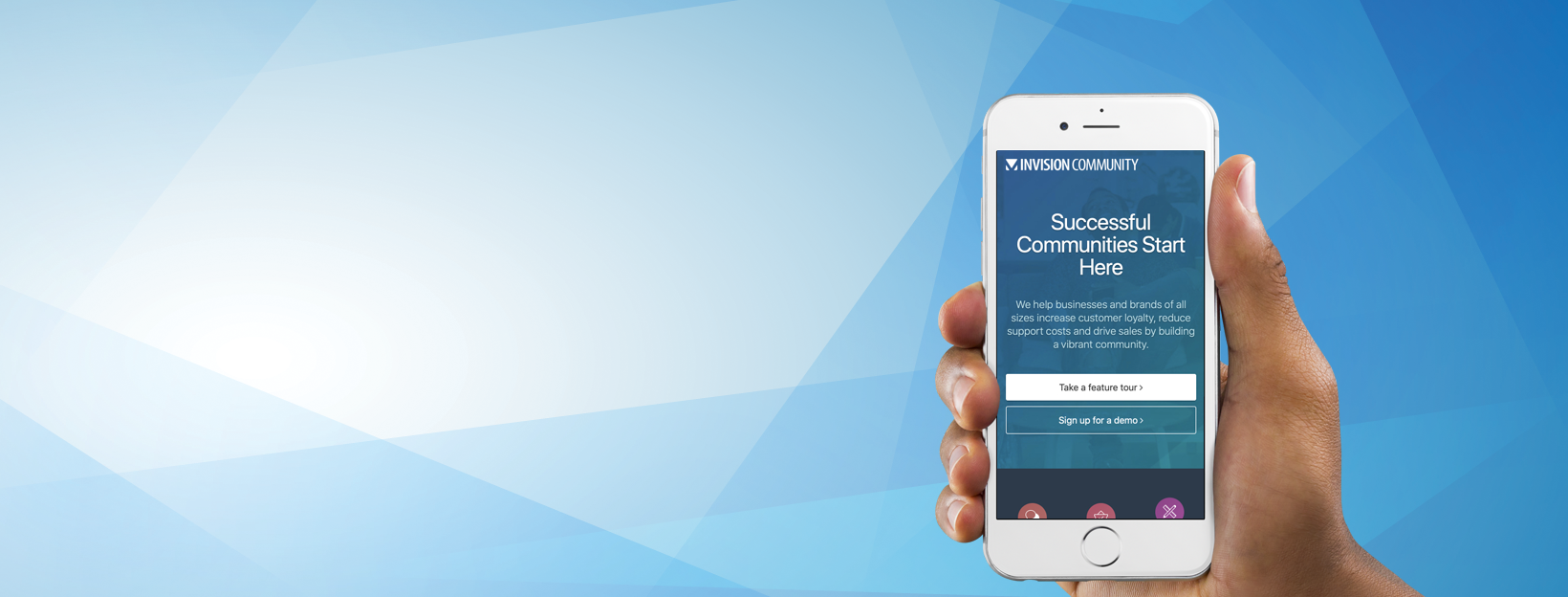
Everything posted by Matt
-
Editor Stock Replies
Wouldn't it be nice if the Invision Community editor could re-use whole replies, text snippets, and even reply templates? As we get ready to welcome more customers into our staffed community support area, this feature idea has become a reality to help form personalized replies. Invision Community has a saved actions feature that allows the community team to perform multiple actions on multiple topics. For example, you might want to add a title prefix, move the topic and add a reply. This works great for 'canned' responses and actions, but it is less useful if you want to edit the reply to personalize it. Stock replies allow you to set up entire replies, partial replies or even reply templates. Stock replies via the editor Once you have these set up in the Admin Panel, they are visible on the editor. Stock replies are configured in the Admin Panel You can choose multiple stock replies to build up a message with handy re-usable reply snippets. stockreplies_video.mp4 Each stock reply has full permission capabilities, meaning you can specify which member groups can use each stock reply. For example, you may wish to create partial replies for your team but encourage members to use a reply template to report bugs, etc. Using stock actions as a template We hope you like this feature, which is coming to our 4.6.7 October release.
-
Hump Day: A Refresh Has Arrived!
Thank you for reminding me of the power and wonder of community. This made my day.
-
Hump Day: A Refresh Has Arrived!
Of course, just drop us a message via ticket or via the contact us form and we'll take care of that for you.
-
Hump Day: A Refresh Has Arrived!
It's the least I can do, but thank you for saying that.
-
Hump Day: A Refresh Has Arrived!
I appreciate that, thank you.
-
Hump Day: A Refresh Has Arrived!
I want to thank you all for your feedback. I appreciate everyone who took the time to leave their thoughts and concerns. I've read every single one and replied to almost all of them. Firstly, I want to say that I understand that the messaging that went out ahead of this update fell short of what you deserve, and I want to apologise for that. After spending two days reading every single post, almost all concerns fall into these three areas: 1) The future of support I've seen many people use the phrase 'no more support', which isn't true. I know the change from ticket support to staffed community support is a significant change, but I genuinely believe that it will benefit customers. I believe that we can create a living knowledge base of solved issues just like many brands do. For example, when I have a problem with my iPhone, I google it and invariably end up with a link to a topic within their support forums with a solved answer. I don't need to raise a ticket with them and wait for a reply. There are many "what about" concerns mixed in, and I ask you to try the new staffed community support areas and give us your feedback once you've used it regularly. We will work with you based on that feedback and make improvements where it is needed. We have custom functionality that shows our team links to your client accounts, including license keys, etc., so we know who you are and have all your information right next to the topic. You will never need to divulge personal information, or even your site URL if you do not want to. If your support issue is complex or needs developer intervention, with a click of a button, our technicians can convert this into a ticket for you and we will continue to resolve the issue with you in that ticket. You will be in safe hands. 2) Price Rises We have not raised our prices for well over a decade. We've always been reluctant to do it and held off for too long, resulting in a large jump to make up for a lost time. We can't reduce the prices to their pre-September levels, but we will be much more mindful of price rises in the future. 3) Annual Renewals We want to simplify billing and reduce the number of invoices we need to send, and you need to pay. An annual invoice seemed logical to achieve this. However, you have made it clear that moving to annual renewals affects your budgeting, and we have listened to that. We have reverted this decision and have restored 6-month renewals in your client area. This is not a temporary one-off offer; it's a permanent change. Again, I want to thank you all for being so vocal and passionate about Invision Community. We want to keep offering you the very best community platform to help your communities succeed.
-
Hump Day: A Refresh Has Arrived!
Done and done!
-
Hump Day: A Refresh Has Arrived!
Themes customisation have never been supported, so you would still need to use the peer-to-peer community forums for those. Our team do look through occasionally but it's not part of their daily workflow.
-
Hump Day: A Refresh Has Arrived!
My apologies, I took this as being literal.
-
Hump Day: A Refresh Has Arrived!
Thanks for taking the time to give me your thoughts. I appreciate this a lot.
-
Hump Day: A Refresh Has Arrived!
I find it hard to believe that the only reason we're stuck on the ground and don't float off into the sky is because the big ball of rock we're living on spins around really fast because a giant ball of fire is so heavy we have no choice. But it's still true. 🚀 I will own that I could have done better with the email for sure. This topic is 17 pages long at the time of writing and a lot of customers have come to tell me that they're unhappy either because of what we've done or how we've done it. I will own that too. It's why I spent pretty much all of yesterday making sure every single person got a reply. I hear you and I'm sorry that I've disappointed you, truly. I do not enjoy upsetting people, even when it is necessary. We're all part of communities, whether we realise it or not. 🙂 Even going into your favourite coffee shop and chatting with the barista and nodding to the laptop user who always sits in the corner is a community. Everything we do either gives or takes from communities. But I respect your point that you are not interested in helping others, and you have no obligation to do so.
-
Hump Day: A Refresh Has Arrived!
No worries, there's a lot going on. 😄
-
Hump Day: A Refresh Has Arrived!
I don't understand, perhaps you misread my reply.
-
Hump Day: A Refresh Has Arrived!
They will be encouraged to use the staffed support community first. Ticket volume from cloud customers is much lower than self-hosted because they don't have the various server-level problems. Outside of "how do I", most self-hosting tickets end up with a developer to diagnose what is often a config / server issue.
-
Hump Day: A Refresh Has Arrived!
The priority support option offers one business day turnaround whereas our standard support (be it in tickets until Jan 22 or via the staffed support community is three days). Generally, we do get to tickets within a day, but it's just something that's baked into the service-level agreement. We are actively planning and mapping it out. There's a lot of moving parts and we cannot have a situation where we do not release anything for 6-12 months, or we have two very different branches which need to merge at some point. Hey, I appreciate your thoughtful reply and thanks for sticking with us for so long. I hope you continue to stick with us as we have an exciting future with many new features in the pipeline. We don't want you to switch, we want you to build and grow your community with us. I hear you. Thanks for sticking with us. I genuinely believe that Invision Community has a strong future. We have a great team and a lot of improvements and new functionality in the pipeline. Thanks for the reply and for sticking with us. I know some of the marketplace devs have been unsettled by this announcement and they know they can always talk to us if they have concerns. Yes, but the starter plan is $49 a month (or $588 a year). We would still encourage cloud customers to post within the community. Appreciate the reply, thanks! We are seeing a steady number of self-hosting customers move over to cloud, which has been a trend over the past year or so as rising hardware costs mean higher hosting costs which reduces the savings gap by running your own hardware / VPS / large hosting account. Stick with us, we've got a lot more to come. 🙂 I understand that you don't like some of our messaging, but a lot of our customers do. Many have reached out privately and said they feel the community has been more fun since Jordan was hired. We can't please everyone though. 🙂 Hey Randy! Nice to hear from you. Really appreciate your thoughtful and detailed reply. Some great thoughts on the developer program. We have a few things to iron out with our staffed community support but it's already feeding back into the core software as we add functionality to make Invision Community 'eat its own dog food' (gross lol). Statistic improvements, a new stock replies feature and more are coming.
-
Hump Day: A Refresh Has Arrived!
Hah, well that's a hot take. Complexity from a billing POV, a user interface POV and yes, people make mistakes and choose the wrong option, then realise a week later and need it fixing. I'm not suggesting our customers can't cope with understanding what a month or year is - simply that the more you offer, the more it can be confusing or easily misunderstood. Yes, we'll do a custom 6 month invoice on your next renewal, but it's not an option we're considering moving forwards. I do care, but what can I say? I can't change people's minds. I hope they reconsider, but I can't make them. I understand your position Davy, and it seems like you're making the right decision for yourself and to secure your communities future and I wish you the best of luck with it. I'm here if you need any help. 🙂
-
Hump Day: A Refresh Has Arrived!
I can talk at length about this and will do at some point. We have a responsive theme, PWA enabled and notifications for those that support them (Android). On our cloud infrastructure, we use CDN to serve a gzipped version of all JS and CSS which helps speed along with caching engines to reduce latency on requests. In terms of what the software can do, we need to break up the monolithic JS and CSS packages and consider relying on jQuery less and using native JS more. However, these are framework breaking changes that will likely take 6-12 months to really complete, so it's not something we can do on a development sprint. We are aware of page speed and are discussing the best way to move forwards. Sometimes, the solution isn't simple and requires some time to implement. I'm sorry to see you go. Good luck with the conversion and thanks for your business. 🙂 Introducing multiple renewal options adds complexity and some confusion. We are offering as a one time offer to split your next annual invoice into a 6 monthly invoice but it won't be a permanent option moving forwards. I don't want to lose a single customer but I respect any decision that our customers make. We didn't increase prices with a view to trimming our customer base. I appreciate the thoughtful reply, thanks. There's lots here to think about.
-
Hump Day: A Refresh Has Arrived!
Appreciate your feedback and insight into why you chose us. Change is hard for sure. It throws up doubt and worry. Time generally helps.
-
Hump Day: A Refresh Has Arrived!
Nope, we haven't taken a dime of investment from anyone, and ownership hasn't changed. We are moving to monthly release cycles now. We're less likely to do a large monolithic annual release. We want to deliver new features and bug fixes more regularly.
-
Hump Day: A Refresh Has Arrived!
I think a few are upset, and are at different points of managing that feeling. I would hope that most see that it is not about greed but rather ensuring a stable future for our customers on our platform.
-
Hump Day: A Refresh Has Arrived!
Can I have his phone number? Just send us a message here. Thanks!
-
Hump Day: A Refresh Has Arrived!
Actually he has raised his prices now you mention it. By roughly 20% (I just checked his website and what I remember paying before). I think any price rise is met with annoyance, no one wants to pay more than they did. I like mine a lot. He knows what I want without me asking for it. I get good service and we have a lot of laughs. I also know he works hard and is good at what he does. We can do a 6 month renewal for you for your next renewal cycle if that's easier for you.
-
Hump Day: A Refresh Has Arrived!
I you can learn Wordress' code, then you can do anything. 🤪 Yes, anything complex or needs logs / screenshots can be moved into a ticket, that's no problem.
-
Hump Day: A Refresh Has Arrived!
Everything is easy until you make a start. 😆 Sadly, even very happy third-party developers can leave at any time, so I don't think it will stop apps being left and no longer updated. When you are doing something part time, any change in your personal life can mean you can't manage it any longer or simple what to do something else.
-
Hump Day: A Refresh Has Arrived!
It sounds like you are a very skilled and knowledgeable person who has managed to resolve your issues by yourself. This is how I learned how to program.





